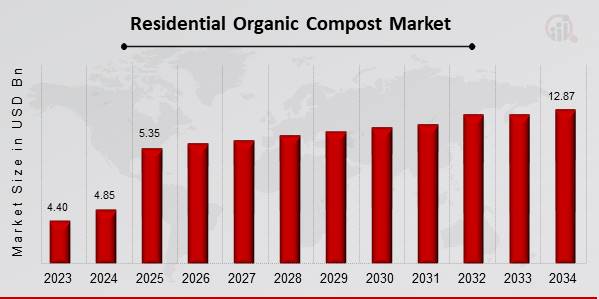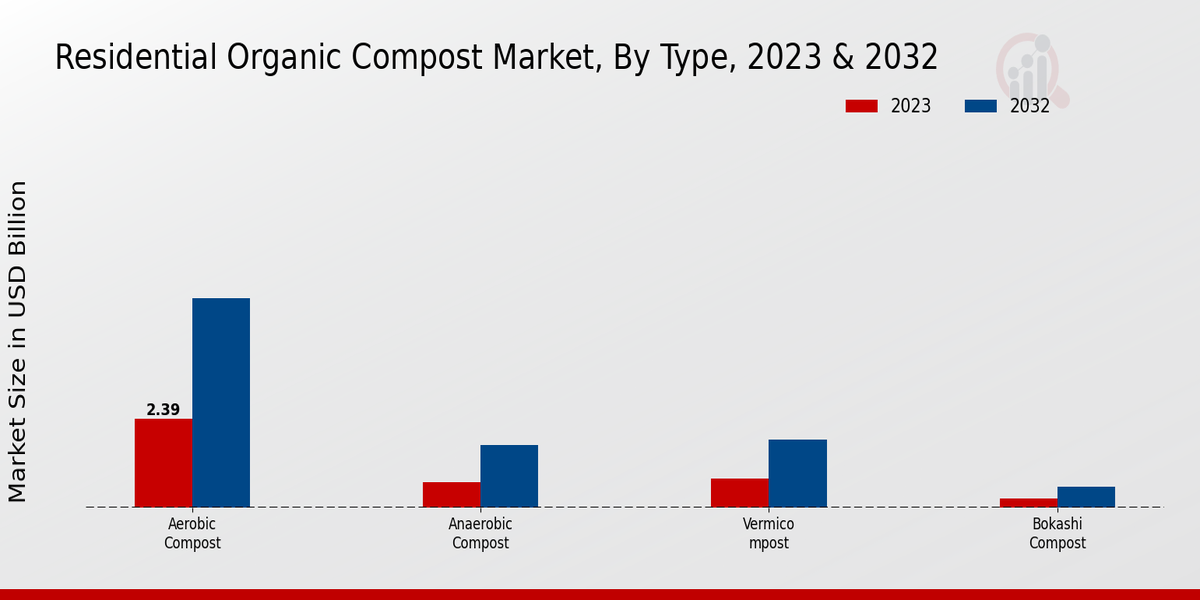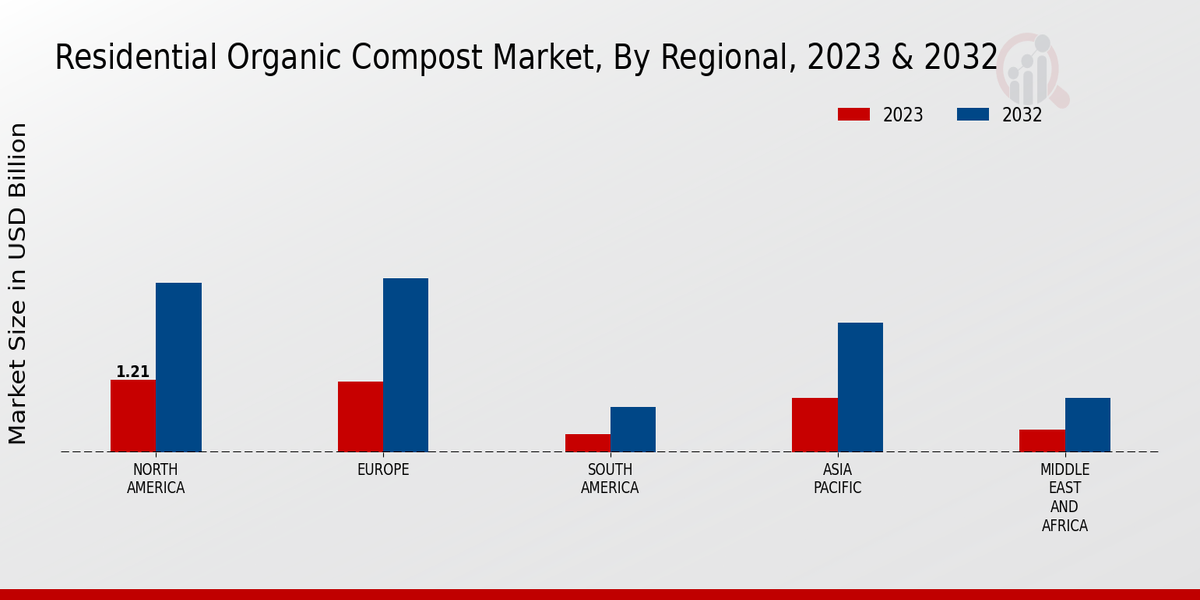Global Residential Organic Compost Market Overview
Residential Organic Compost Market Size was estimated at 4.85 (USD Billion) in 2024. The Residential Organic Compost Market Industry is expected to grow from 5.35 (USD Billion) in 2025 to 12.87 (USD Billion) by 2034. The Residential Organic Compost Market CAGR (growth rate) is expected to be around 10.3% during the forecast period (2025 - 2034).
 Source Primary Research, Secondary Research, MRFR Database and Analyst Review
Key Residential Organic Compost Market Trends Highlighted
Source Primary Research, Secondary Research, MRFR Database and Analyst Review
Key Residential Organic Compost Market Trends Highlighted
Growing environmental concerns and increasing awareness of sustainable practices have fueled the demand for residential organic compost. Consumers are increasingly adopting organic gardening methods to reduce chemical fertilizer usage and promote soil health, driving the market's expansion. Additionally, government initiatives and regulations promoting organic waste management have created favorable conditions for the industry. The trend towards urban gardening and the growing number of home composting systems have further expanded the market reach. Technological advancements in composting techniques have also contributed to the industry's growth, enhancing efficiency and reducing composting time. The residential organic compost market presents significant opportunities for both existing and new players to capitalize on the increasing demand for sustainable solutions.
Residential Organic Compost Market Drivers
Environmental Awareness and Sustainability Concerns Driving Demand for Organic Compost
The populations around the world are expanding, therefore, the tendencies of sustainable and environmentally friendly industries are rapidly rising. Conventional farming methods have a negative influence on the environment, and people want to consume organic crops. Organic composting is vital in sustainable agriculture, as it helps to improve soil health and reduces the necessity to use chemical fertilizers. Increasing pollution of the environment and the high demand for organic crops will drive the growth of the Residential Organic Compost Market Industry.
Government Incentives and Regulations Supporting Organic Compost Adoption
The benefits and positive outcomes of organic composting are becoming more and more recognized and important worldwide. Organic composting is crucial for sustainable agriculture and reduced environmental impact and governments worldwide implement regulations and policies actively. One of such effective encouragements is the use of financial means in the sphere, as many countries implement subsidies and tax breaks for farmers that use organic compost.
An additional “driving side” of the process are the several regulations that were in place recently, restricting the use of chemical fertilizers and, in turn, favoring the market of organic compost.
Technological Advancements Enhancing Compost Production and Quality
In addition, the development of technology in the sector is also benefiting the Residential Organic Compost Market Industry. Composting equipment and methods are improving and beneficial, such as more efficient work or higher compost quality. The temperature, moisture, as well as aeration of the composting pile has been controlled and regulated effectively via automatic composting systems. Additionally, researchers continue to become active in the creation of new compost products that are just as transformative.
These are intended to meet the needs of specific plants as well as soil types and are novel.
Residential Organic Compost Market Segment Insights
Residential Organic Compost Market Type Insights
The Residential Organic Compost Market is segmented by type into Aerobic Compost, Anaerobic Compost, Vermicompost, and Bokashi Compost. Among these, Aerobic Compost held the largest market share in 2023, accounting for over 60% of the Residential Organic Compost Market revenue. Aerobic composting involves breaking down organic matter in the presence of oxygen, resulting in a nutrient-rich compost that is ideal for improving soil health and plant growth. The increasing adoption of sustainable gardening practices and the growing awareness of the environmental benefits of composting are driving the growth of the Aerobic Compost segment.
Anaerobic Compost, on the other hand, is produced without oxygen and has a distinct odor. It is commonly used as a soil amendment and fertilizer in organic farming and gardening. The Anaerobic Compost segment is expected to witness significant growth in the coming years, driven by the increasing demand for organic fertilizers and the need for sustainable waste management solutions. Vermicompost, also known as worm compost, is produced by earthworms feeding on organic matter. It is considered a high-quality compost due to its rich nutrient content and beneficial microorganisms.
The Vermicompost segment is gaining popularity among home gardeners and urban farmers due to its effectiveness in improving soil fertility and plant health. Bokashi Compost is a fermented compost produced using a specific blend of microorganisms. It is known for its ability to suppress pathogens and enhance nutrient availability in the soil. The growing awareness of the benefits of organic composting, the increasing adoption of sustainable gardening practices, and the need for effective waste management solutions are key factors driving the growth of the market.
 Source Primary Research, Secondary Research, MRFR Database and Analyst Review
Residential Organic Compost Market Application Insights
Source Primary Research, Secondary Research, MRFR Database and Analyst Review
Residential Organic Compost Market Application Insights
The application segment of the Residential Organic Compost Market holds significant importance, influencing the market growth and dynamics. In 2023, the gardening segment accounted for the largest revenue share, estimated at USD 1.23 billion. This dominance stems from the rising popularity of home gardening and the increasing awareness of organic gardening practices. Landscaping is another major application, with a projected revenue of USD 1.05 billion in 2023. The use of organic compost in landscaping enhances soil health, improves plant growth, and reduces the need for chemical fertilizers.
Soil amendment, rooftop gardens, and urban farming are also notable applications, contributing to the overall market growth. The increasing urbanization and the growing demand for sustainable food production are driving the adoption of organic compost in these areas.
Residential Organic Compost Market Function Insights
The Function segment of the Residential Organic Compost Market is categorized into Soil Fertility Improvement, Water Retention Enhancement, Disease Suppression, Carbon Sequestration, and Waste Reduction. Among these, Soil Fertility Improvement holds the largest market share due to the increasing demand for organic farming practices and the need to enhance soil health. Water Retention Enhancement function is also gaining traction as it helps reduce water consumption in agriculture, especially in arid regions. Disease Suppression function is expected to witness significant growth over the forecast period as organic compost helps in suppressing soil-borne diseases and promoting plant growth.
Carbon Sequestration function is gaining importance due to its role in mitigating climate change by capturing and storing carbon in the soil. Lastly, Waste Reduction function plays a crucial role in diverting organic waste from landfills, promoting sustainability and circular economy practices. The Residential Organic Compost Market is expected to reach USD 4.56 billion in 2024, exhibiting a CAGR of 10.5% during the forecast period 2023-2032.
Residential Organic Compost Market End User Insights
End User Insights and Overview The Residential Organic Compost Market is primarily segmented into end users, including homeowners, gardeners, farmers, landscapers, and sustainability enthusiasts. Homeowners represent the largest end user segment, utilizing organic compost for improving soil health and plant growth in their gardens, lawns, and outdoor spaces. With the growing awareness of sustainable gardening practices, homeowners are increasingly adopting organic compost to reduce chemical fertilizer usage and promote ecosystem balance. Gardeners, a dedicated end user group, employ organic compost to enhance soil fertility, moisture retention, and disease resistance for their flower beds, vegetable patches, and other horticultural endeavors.
Farmers, particularly in the organic agriculture sector, are major consumers of organic compost. They utilize it to improve soil structure, increase crop yields, and reduce reliance on synthetic fertilizers. Landscapers leverage organic compost for commercial landscaping projects, enhancing soil quality, reducing erosion, and promoting healthy plant growth in parks, green spaces, and urban areas. Sustainability enthusiasts, driven by a desire to reduce environmental impact and promote circularity, actively seek out organic compost to improve soil health, sequester carbon, and minimize waste generation in their gardens and communities.
The Residential Organic Compost Market is projected to reach a value of USD 4.6 billion by 2024, driven by the growing demand from these end user segments and the increasing recognition of organic compost's environmental and agricultural benefits.
Residential Organic Compost Market Regional Insights
The Residential Organic Compost Market segmentation by region is a crucial aspect to understand the market dynamics. North America held a significant market share due to increasing environmental awareness and government regulations promoting sustainable practices, with values of 1.211 USD Billion in 2023 and 2.848 USD Billion by 2032. Europe closely follows, driven by stringent waste management policies and a growing focus on organic farming, with values of 1.188 USD Billion in 2023 and 2.923 USD Billion by 2032. The APAC region is anticipated to witness substantial growth, attributed to rising urbanization, increasing population, and a growing middle class with disposable income, with values of 0.906 USD Billion in 2023 and 2.168 USD Billion by 2032.
South America and MEA are expected to contribute to the market growth due to increasing demand for organic products and government initiatives to promote sustainable agriculture, with values of 0.305 USD Billion in 2023 and 0.755 USD Billion by 2032 for South America, and 0.381 USD Billion in 2023 and 0.906 USD Billion by 2032 for Middle East and Africa. Overall, the Residential Organic Compost Market is expected to experience significant growth in the coming years, driven by increasing consumer awareness and demand for sustainable solutions.
 Source Primary Research, Secondary Research, MRFR Database and Analyst Review
Residential Organic Compost Market Key Players And Competitive Insights
Source Primary Research, Secondary Research, MRFR Database and Analyst Review
Residential Organic Compost Market Key Players And Competitive Insights
Major players in Residential Organic Compost Market industry are focusing on expanding their product portfolio, increasing their production capabilities, and enhancing their distribution channels to meet the growing demand for residential organic compost. Leading Residential Organic Compost Market players are also investing in research and development to develop innovative products and technologies that can improve the quality and efficiency of their compost. The Residential Organic Compost Market is highly competitive, with a number of key players operating in the market. Some of the leading players in the market include Scotts Miracle-Gro, The Scotts Company LLC, Sun Gro Horticulture, and Agromaster. These companies are investing heavily in research and development to improve the quality and efficiency of their products, and they are also expanding their distribution channels to reach more customers.
The Scotts Miracle-Gro Company is a leading manufacturer and marketer of consumer lawn and garden products. The company's products include fertilizers, herbicides, pesticides, and grass seed. The Scotts Miracle-Gro Company also manufactures and markets a variety of organic gardening products, including compost. The company's compost products are made from recycled plant materials, and they are designed to improve the quality of soil and plants. The Scotts Miracle-Gro Company is headquartered in Marysville, Ohio, and it has operations in over 100 countries.
One of the leading competitors in the Residential Organic Compost Market is Agromaster. Agromaster is a leading provider of organic fertilizers and compost. The company's products are used by farmers, gardeners, and landscapers to improve the quality of their soil and plants. Agromaster's compost products are made from recycled plant materials, and they are designed to improve the soil's structure, water retention, and nutrient content. Agromaster is headquartered in Fresno, California, and it has operations in over 20 countries.
Key Companies in the Residential Organic Compost Market Include
-
Bumper Crop Compost
-
CompostWorks
-
Urth
-
Black Gold Compost Company
-
Naturescape Products
-
Red Wiggler Trading Company
-
Zume
-
Worm Power
-
Terra Nova Nurseries
-
Organic Mechanics Soil Company
-
Nature's Way Resources
-
The Compost Bin
-
Nature's Choice Organic Products
-
Soil3
-
Sun Gro Horticulture
-
AgroCare
Residential Organic Compost Market Industry Developments
The residential organic compost market is projected to reach USD 9.6 billion by 2032, exhibiting a CAGR of 10.25% during the forecast period. Rising environmental consciousness, coupled with growing demand for sustainable gardening practices, is driving market growth. Government initiatives promoting organic farming and waste reduction further contribute to the market's expansion. Key players are focusing on product innovation and strategic partnerships to gain a competitive edge. Recent developments include collaborations between compost manufacturers and waste management companies to enhance waste diversion and promote circular economy models. Technological advancements in composting techniques, such as vermicomposting and automated systems, are also shaping the market landscape, leading to improved efficiency and reduced production costs.
Residential Organic Compost Market Segmentation Insights
Residential Organic Compost Market Type Outlook
Aerobic Compost
Anaerobic Compost
Vermicompost
Bokashi Compost
Residential Organic Compost Market Application Outlook
Gardening
Landscaping
Soil Amendment
Rooftop Gardens
Urban Farming
Residential Organic Compost Market Function Outlook
Soil Fertility Improvement
Water Retention Enhancement
Disease Suppression
Carbon Sequestration
Waste Reduction
Residential Organic Compost Market End User Outlook
Homeowners
Gardeners
Farmers
Landscapers
Sustainability Enthusiasts
Residential Organic Compost Market Regional Outlook
North America
Europe
South America
Asia Pacific
Middle East and Africa
| Report Attribute/Metric |
Details |
| Market Size 2024 |
4.85 (USD Billion) |
| Market Size 2025 |
5.35 (USD Billion) |
| Market Size 2034 |
12.87 (USD Billion) |
| Compound Annual Growth Rate (CAGR) |
10.3% (2025 - 2034) |
| Report Coverage |
Revenue Forecast, Competitive Landscape, Growth Factors, and Trends |
| Base Year |
2023 |
| Market Forecast Period |
2025 - 2034 |
| Historical Data |
2019 - 2023 |
| Market Forecast Units |
USD Billion |
| Key Companies Profiled |
Bumper Crop Compost, CompostWorks, Urth, Black Gold Compost Company, Naturescape Products, Red Wiggler Trading Company, Zume, Worm Power, Terra Nova Nurseries, Organic Mechanics Soil Company, Nature's Way Resources, The Compost Bin, Nature's Choice Organic Products, Soil3, Sun Gro Horticulture, AgroCare |
| Segments Covered |
Type, Application, Function, End User, Regional |
| Key Market Opportunities |
Sustainable gardening trends Urban gardening initiatives Government composting subsidies Increased awareness of organic benefits Ecommerce for compost products |
| Key Market Dynamics |
Growing consumer awareness Government incentives for composting Rise in organic gardening trends Urbanization driving waste management solutions Increased demand for sustainable products |
| Countries Covered |
North America, Europe, APAC, South America, MEA |
Frequently Asked Questions (FAQ) :
The market size of the Residential Organic Compost Market is expected to be valued at 4.85 billion USD in 2024.
By 2034, the Residential Organic Compost Market is anticipated to reach an overall valuation of 12.87 billion USD.
The CAGR for the Residential Organic Compost Market from 2025 to 2034 is projected to be 10.3%.
Regions such as North America, Europe, and Asia-Pacific are expected to show significant growth in the Residential Organic Compost Market.
The Residential Organic Compost Market is primarily driven by applications in residential gardening, landscaping, and organic farming.
Key competitors in the Residential Organic Compost Market include several large companies and local manufacturers contributing to market growth.
The North American market size for Residential Organic Compost is expected to contribute significantly to the overall valuation by 2034.
Increasing consumer awareness regarding sustainability and organic gardening is positively impacting the growth of the Residential Organic Compost Market.
Urbanization is driving demand for residential organic compost as more people engage in gardening and landscaping in urban areas.
Government initiatives promoting organic farming and waste management are facilitating the growth of the Residential Organic Compost Market.

















